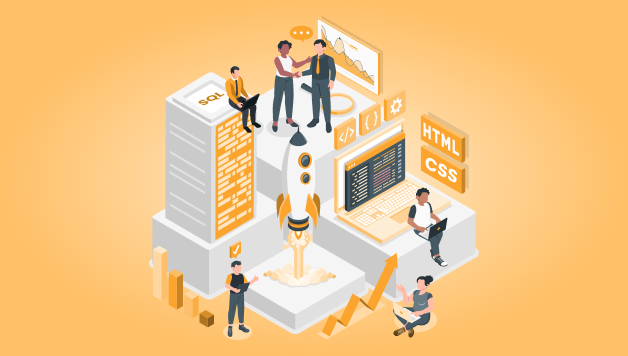In the fast-paced web development world, it takes more than coding to keep ahead of the curve, where special tools come into the equation. Introducing full-stack frameworks: sine-qua-non for modern web applications allowing developers to take on backend and frontend processes at once. Everything in web development-trends and technologies-is changing in 2025. It really matters for developers to know which trends are leading the pack. For this reason, here's a summary of the 10 best full stack framework that the developer should consider in the year 2025.
1. Next.js:
Next.js is still one of the options for developers because it can be fully utilized in sync with React and helps build high-performance web applications. Its features, such as server-side rendering (SSR) and static site generation (SSG) ensure faster websites and better SEO. In 2025, Next.js is at the top as one of the full-stack frameworks for the best support of TypeScript, API routes and an optimized developer experience.
2. NestJS:
Developed on top of Node.js, NestJS emerged because of its robust architecture that was inspired by Angular and became the favorite of the developers. It natively supports TypeScript and has modularity that supports scalability and maintainability. It is really flexible and one can make RESTful APIs, microservices or GraphQL applications using it. If you want to create dynamic landing pages, then NestJS is definitely worth considering in 2025.
3. Ruby on Rails:
The famous Rails, often referred to simply as Ruby on Rails, is the one that endures in the development community under simplicity and convention over configuration. A large ecosystem of plugins commonly known as gems provides this framework with enough speed for developers to deliver web applications faster. And making things even better, updates as recent as 2025 simply add strength to make it reliable for any developer who seeks to have a scalable database-driven application.
4. Django:
Django is still a heavy weight on the Python scene because of its "batteries-included" philosophy. From these full stack frameworks, there are many complex tasks that may include migrating the database, authentication processes and routing URLs easily. Being founded primarily on security, Django truly becomes very useful in handling sensitive information; thus, it's perfect in any given e-commerce and even financial platforms for 2025. Its scalability feature coupled with community support and even more make it an all-time choice for developers around the globe.
5. Spring Boot:
For years, Java developers have depended on Spring Boot to simplify the process of building enterprise-level applications.Spring Boot reduces configuration; it offers powerful dependency injection tools that enable developers to build strong, production-worthy applications within no time. When in the year 2025, enterprises demand reliable scalable web solutions, Spring Boot is surely one of the best possible full-stack frameworks for carrying out large-scale projects.
6. SvelteKit:
Its approach to working with parts and reactivity is revolutionizing development. As it's compiled at build time, SvelteKit writes code differently than other more traditional JavaScript frameworks, making for faster web applications and a more natural approach by 2025. It'll have a growing ecosystem, perhaps most importantly, it will be simple toward that goal. Developers who can find and focus on the creation of interactive landing pages will want to be watching and adopting its concepts.
7. Laravel:
And of course, Laravel, having a PHP-based framework behind elegant syntax and a thoroughly complete feature set, provides loads of built-in tools like its routing, middleware, authentication which makes developing fantastic user experiences much less effort for developers. Its extremely well-developed ecosystem, featuring resources such as Laravel Nova, Forge, puts it amongst very strong contenders in best full stack framework for 2025.
8. Meteor.js:
Meteor.js offers a streamlined, JavaScript environment for real-time applications building. It's useful, especially for developers who still want to take advantage of MongoDB integration and single-codebase support for both web and mobile applications in 2025. Its one-click setup for either a SaaS platform or even the simplest dynamic landing pages doesn't matter if you just started or are already well advanced into your development career.
9. Flask + React:
Even though Flask is technically a micro-framework, when combined with React, it becomes a really powerful full-stack framework. On one side, Flask takes care of the backend in a simple yet fast way, while React is there to handle the front-end user interface. For developers who wish for a more granular control over their tech stack without giving away flexibility, this combination would be ideal in 2025. This setup proves helpful in making custom landing page examples that need precise control both in the front-end and the back-end.
10. Remix:
Remix is one of the bright stars in the world of web development services that is focused on optimizing performance and experience for developers. It highly focuses on server-side rendering, form handling, and data fetching, which in turn makes it very simple for developers to build more resilient web applications. With this being a mix of the traditional and modern developments, it ends up being one of the best full-stack frameworks to be followed for 2025 especially to build a responsive and SEO-friendly site.
Conclusion
The web development landscape in 2025 is diverse, with full stack frameworks evolving to meet the needs of modern developers. Whether you’re building enterprise applications, dynamic landing pages, or real-time platforms, choosing the right framework is crucial. By considering frameworks like Next.js, Django, and Remix, you’ll be equipped to tackle any project with confidence. As the trends change, staying updated with the best full stack framework will ensure that your projects remain efficient, scalable, and competitive.





Comments